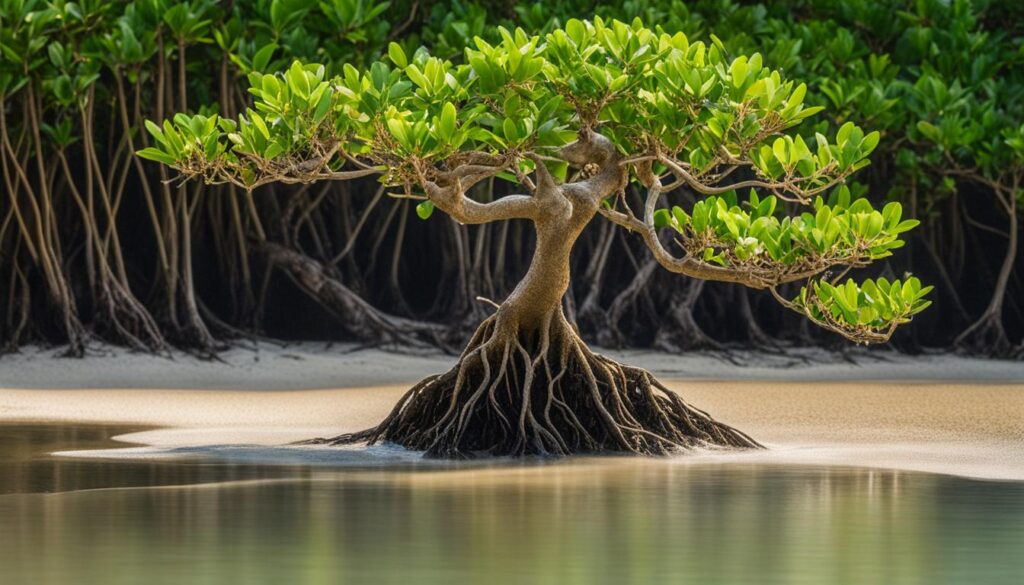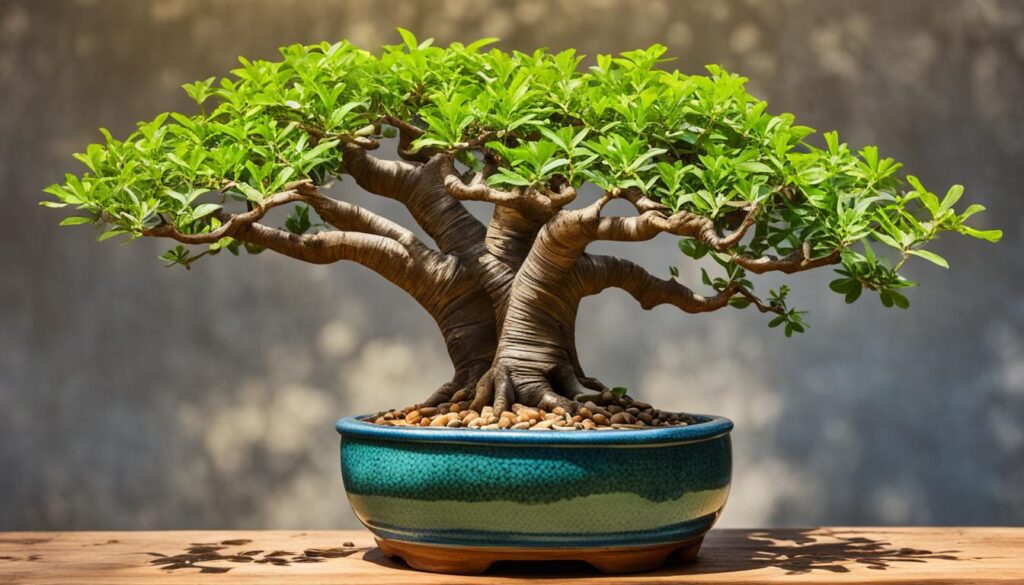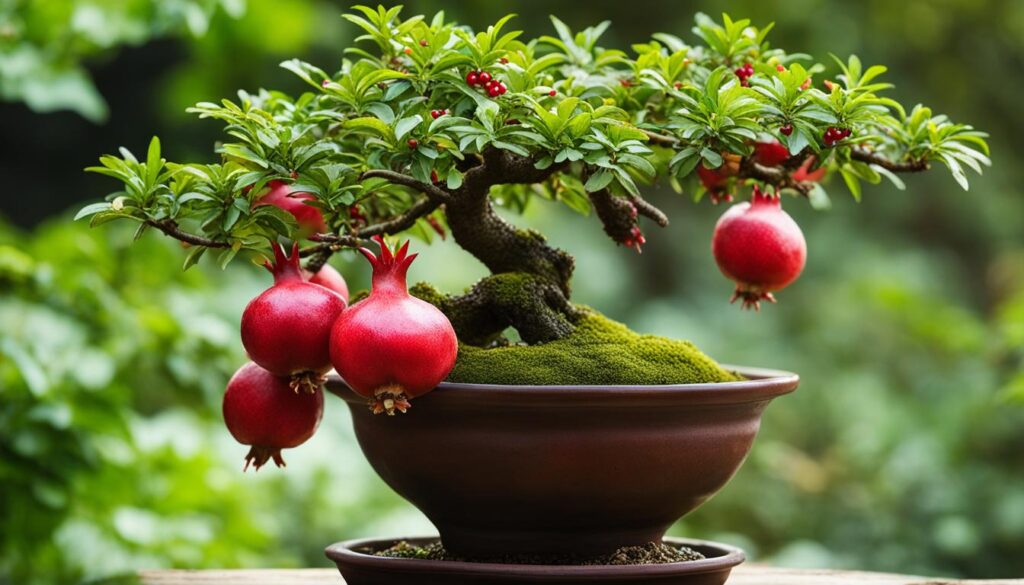If you are interested in the beauty of miniature trees, you are in the right place. This guide covers how to cultivate Mangrove Bonsai Trees, detailing their features and care requirements.
Why choose a Mangrove Bonsai Tree? These trees stand out with their unique roots and delicate leaves. They create a peaceful atmosphere in any setting and bring tranquility to your home or office.
This guide offers step-by-step instructions for growing and caring for your Mangrove Bonsai Tree. Topics include selecting species, finding the right soil, potting, watering, light and temperature balance, pruning, and maintenance tips.
Introduction to Bonsai Mangroves
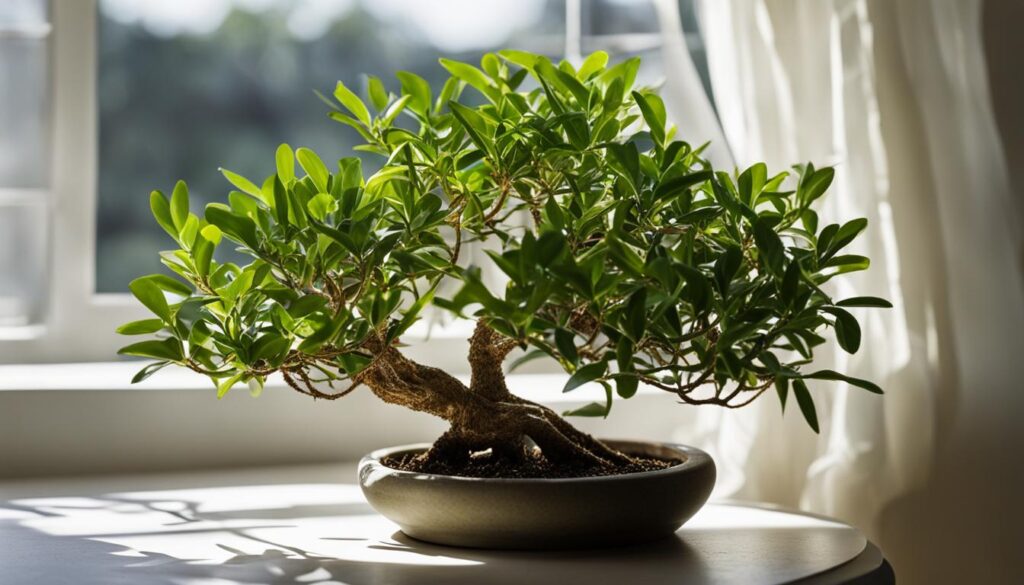
This section introduces Bonsai Mangroves. Discover the art of bonsai and how mangroves become beautiful miniature sculptures. Learn the history and meaning of bonsai mangroves and appreciate their beauty.
“Bonsai is not just about growing trees in pots; it is an art form that allows us to connect with nature on a profound level.”
Bonsai is a Japanese art that focuses on growing and shaping miniature trees. The term “bonsai” means “tray planting.” This practice dates back over a thousand years. In bonsai, trees are pruned and trained to resemble their larger versions, creating stunning landscapes.
Bonsai mangroves are a stunning type of bonsai tree. They capture the essence of mangroves and create enchanting miniature scenes. These trees bring the calming essence of mangrove forests into your space, allowing you to enjoy their charm closely.
The art of bonsai symbolizes harmony, balance, and the fleeting nature of life. Growing a bonsai mangrove tree promotes patience, mindfulness, and a strong bond with nature.
By practicing bonsai, you can create a peaceful spot in your home or garden. As you explore bonsai mangroves, you will learn how to grow and care for them. This journey offers fulfilling artistic expression and a connection to nature.
Understanding the Unique Features of Mangrove Bonsai Trees
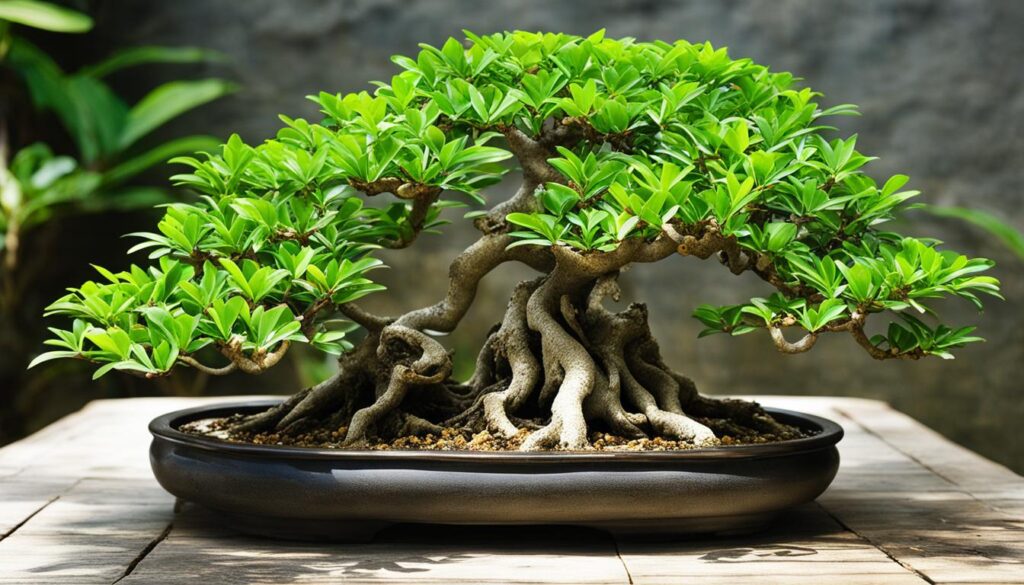
In this section, we will explore the unique features of Mangrove Bonsai Trees. These captivating trees have a distinctive aesthetic that sets them apart. We will also discuss their ecological importance and environmental benefits.
Defining the Mangrove Bonsai Aesthetic
Mangrove Bonsai Trees are known for their intriguing look. Their complex root systems and small leaves create a sense of tranquility. The balance between the miniature size and the tree’s structure invokes awe.
When cultivating a Mangrove Bonsai Tree, attention to detail is important. Each branch, root, and leaf contributes to the tree’s overall look. The shaping and pruning process allows you to create unique forms and styles, reflecting your artistic vision. Whether you prefer a windswept look or a cascading design, the options are endless.
Ecological Importance and Environmental Benefits
Besides their beauty, Mangrove Bonsai Trees play an important role in the ecosystem. These trees provide several environmental benefits that make them valuable:
- Improved Air Quality: Mangrove Bonsai Trees act as natural air purifiers by absorbing carbon dioxide and releasing oxygen. This process improves air quality, creating a healthier environment for you and those around you.
- Shoreline Stabilization: The dense root systems of Mangrove Bonsai Trees protect against coastal erosion. Their roots stabilize shorelines, preventing soil erosion and protecting coastal areas.
- Habitat for Various Species: Mangrove Bonsai Trees provide habitats for many species. Their foliage and roots offer shelter and nesting grounds, promoting a diverse ecosystem.
Mangrove Bonsai Trees provide visual beauty and environmental benefits. By cultivating these trees, you help the planet while creating a captivating oasis in your space.
Selecting Your Mangrove Bonsai Tree: Species and Varieties
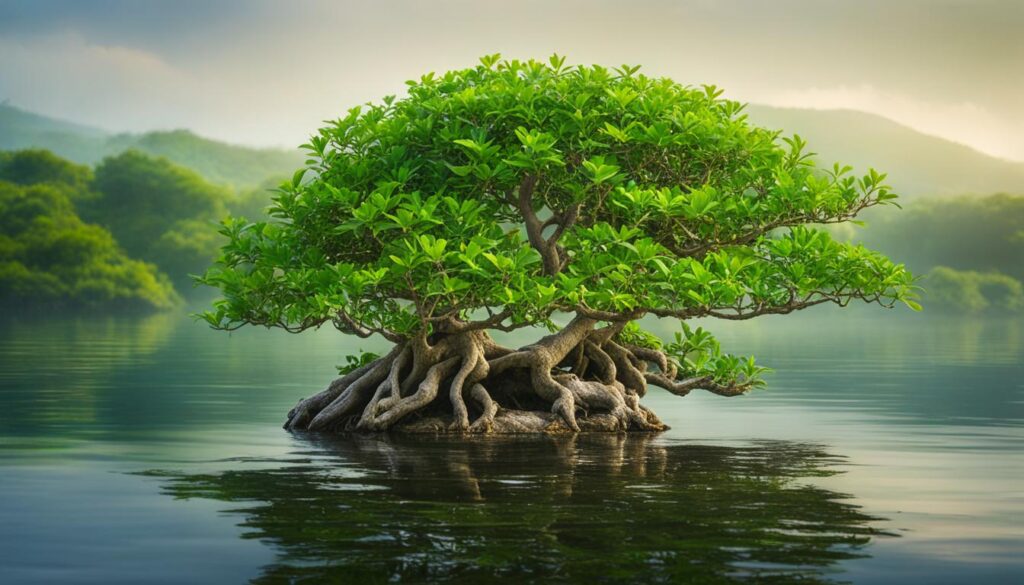
Choosing the right species of Mangrove Bonsai Tree is crucial for success. Each species has unique characteristics and requirements. Here are some popular species of mangrove bonsai trees:
- Rhizophora mangle: Known as the Red Mangrove, this species has distinctive prop roots for stability.
- Avicennia germinans: Also called the Black Mangrove, this species features pneumatophores for oxygen absorption in wet environments.
- Laguncularia racemosa: The White Mangrove has smooth white bark and thrives in brackish or saltwater.
- Bruguiera spp: This genus includes species like Bruguiera cylindrica. These mangrove bonsai trees have striking aerial roots and intricate branching patterns.
When choosing a mangrove bonsai tree, select a healthy specimen. Look for vibrant green leaves, strong roots, and a well-structured trunk. Avoid trees with yellowing or wilted leaves or signs of pests or disease.
To ensure quality, buy from reputable sellers who specialize in bonsai trees. They often have a wide selection of mangrove bonsai trees, allowing you to pick the perfect specimen.
Creating a serene oasis with a mangrove bonsai tree starts with selecting the right species. Research and choose wisely, and you will have a captivating miniature tree that brings beauty to your home or garden.
Mangrove Bonsai Tree Care Essentials

Proper care is essential for your Mangrove Bonsai Tree. Follow these guidelines to ensure its health.
Optimum Soil Composition and Potting Requirements
The soil composition is vital for your Mangrove Bonsai Tree’s growth. Use a well-draining soil mix for proper air circulation and moisture retention. A mixture of organic-rich soil, such as peat moss or compost, with coarse sand or perlite improves drainage. Ensure your pot has drainage holes to prevent waterlogging.
Watering Techniques for Healthy Growth
Proper watering is key to your Mangrove Bonsai Tree’s health. Water when the top inch of the soil feels slightly dry. Avoid overwatering to prevent root rot. When watering, soak the soil thoroughly and let excess water drain out. Adjust the frequency based on humidity and season.
Light and Temperature: Finding the Right Balance
Mangrove Bonsai Trees need bright, indirect light. Place your bonsai near a window for sunlight but avoid direct sunlight, which can scorch leaves. If natural light is limited, use artificial grow lights. They prefer warm, tropical conditions with temperatures between 70-85°F (21-29°C) during the day and 60-70°F (15-21°C) at night. Avoid drafts or extreme temperature changes.
How to Grow Mangrove Bonsai Tree: A Step-by-Step Process
Start your journey of growing a Mangrove Bonsai Tree with this detailed step-by-step process. Whether you are a beginner or experienced, this guide offers the knowledge for success.
1. Germination and Seedling Care: Select high-quality mangrove bonsai tree seeds. Soak seeds in water for 24 hours. Plant in a well-draining bonsai soil mix, barely covered. Keep the environment moist by misting regularly. Place in a warm spot, ideally around 80°F (27°C), with indirect sunlight.
2. Nurturing the Seedlings: Once seedlings emerge, continue proper care. Keep the soil moist but avoid overwatering. Place seedlings in bright, indirect sunlight for 12-16 hours daily. Maintain a temperature range of 70-85°F (21-29°C).
3. Pruning and Training: As seedlings grow, prune and shape them to achieve the desired bonsai look. Use sharp bonsai shears to remove unwanted branches. Use wire to guide growth and create the desired form. Regular pruning helps cultivate a well-formed Mangrove Bonsai Tree.
4. Watering and Fertilizing: Keep the soil slightly moist but not waterlogged. Water thoroughly, allowing excess to drain. Avoid letting the soil dry out completely. Apply balanced bonsai fertilizer at half-strength every two weeks during the growing season to provide nutrients.
5. Light and Temperature: Mangrove Bonsai Trees thrive in bright, indirect sunlight. Ensure they receive at least 6-8 hours of sunlight daily. Protect from extreme temperature changes, with the ideal range between 70-85°F (21-29°C).
6. Potting and Repotting: Repot your Mangrove Bonsai Tree every 1-2 years to provide fresh soil and promote root health. Choose a pot that allows for drainage and provides space for root growth. During repotting, trim excessively long or tangled roots and adjust the tree’s position as necessary.
By following these instructions, you can cultivate a thriving Mangrove Bonsai Tree. Observe and respond to its needs, ensuring it receives the proper care and attention.
Pruning and Maintenance: Shaping Your Mangrove Bonsai
Pruning and maintenance are key for shaping your Mangrove Bonsai Tree. Proper techniques help achieve the desired shape while promoting healthy growth. Regular maintenance ensures overall well-being. This section covers when and how to prune your bonsai mangroves and tips for preventing pests and diseases.
When and How to Prune Your Bonsai Mangroves
Pruning is vital for shaping and refining the tree’s form. Timing and technique greatly influence the tree’s health and appearance. Follow these guidelines for pruning your Mangrove Bonsai Tree:
- Timing: Prune during the tree’s dormant period, typically early spring or late winter. This allows for quick recovery and stimulates new growth.
- Branch Selection: Remove any undesirable branches that disrupt form or compromise health. Keep branches that contribute to the desired shape.
- Pruning Technique: Use sharp, clean bonsai shears for precise cuts. Trim branches above a leaf node or bud to encourage new growth in the desired direction.
- Thinning: Thin overcrowded areas by removing excess branches or foliage. This enhances light and air circulation, promoting overall health.
Preventing Pests and Diseases in Mangrove Bonsai
Mangrove Bonsai Trees can be affected by pests and diseases. However, you can protect your bonsai with proper preventive measures. Here are some essential tips:
- Cleanliness: Keep your bonsai environment clean by removing fallen leaves, dead branches, and debris that may harbor pests or diseases.
- Monitoring: Regularly check for signs of pests, such as visible insects, webs, or leaf damage. Watch for disease symptoms like discoloration, wilting, or unusual growth.
- Quarantine: If you suspect an infestation or disease, isolate the affected bonsai to prevent spreading to other plants.
- Natural Control: Use natural methods, such as beneficial insects or organic pest control products, to manage pests without harming the tree.
- Proper Watering: Avoid overwatering, as excess moisture can lead to fungal diseases. Water only when the topsoil feels slightly dry.
By following these pruning techniques and preventive measures, you can ensure the health and beauty of your Mangrove Bonsai Tree. Next, we will explore where to buy quality Mangrove Bonsai Trees and how to identify reputable sellers.
The Joy of Cultivating Mangrove Bonsai Trees: Long-Term Benefits
Enjoy the satisfaction that comes with cultivating and caring for your own Mangrove Bonsai Trees. These captivating trees offer many long-term benefits that enhance your life.
Tending to your Mangrove Bonsai Tree is a meditative practice. As you prune, shape, and nurture your tree, you will find a peaceful state of mind. Bonsai care connects you with nature, providing a therapeutic escape from daily stresses. It is a calming ritual that helps you find balance.
Mangrove Bonsai Trees also add beauty to any space. Their intricate foliage, delicate branches, and stunning roots create landscapes that add elegance to your home or office. Whether on a windowsill, desk, or mantelpiece, these bonsai trees become living art pieces that inspire.
The long-term benefits of cultivating Mangrove Bonsai Trees go beyond personal fulfillment. These trees provide ecological advantages. They improve air quality by absorbing carbon dioxide and releasing oxygen, help stabilize shorelines, and offer habitats for various wildlife. By nurturing a Mangrove Bonsai Tree, you contribute to a healthier planet.
Unlock the Secrets to Perfect Bonsai Tree Moss: A Must-Read Guide! >>>
The Shocking Reason Your Bonsai Tree Leaves Are Turning Yellow – Find Out Now! >>>
Unlock the Secrets of Bonsai: Discover the Most Stunning Varieties You Never Knew Existed! >>>
Unlock the Secrets to Thriving Black Pine Bonsai: Your Ultimate Growing and Care Guide! >>>

